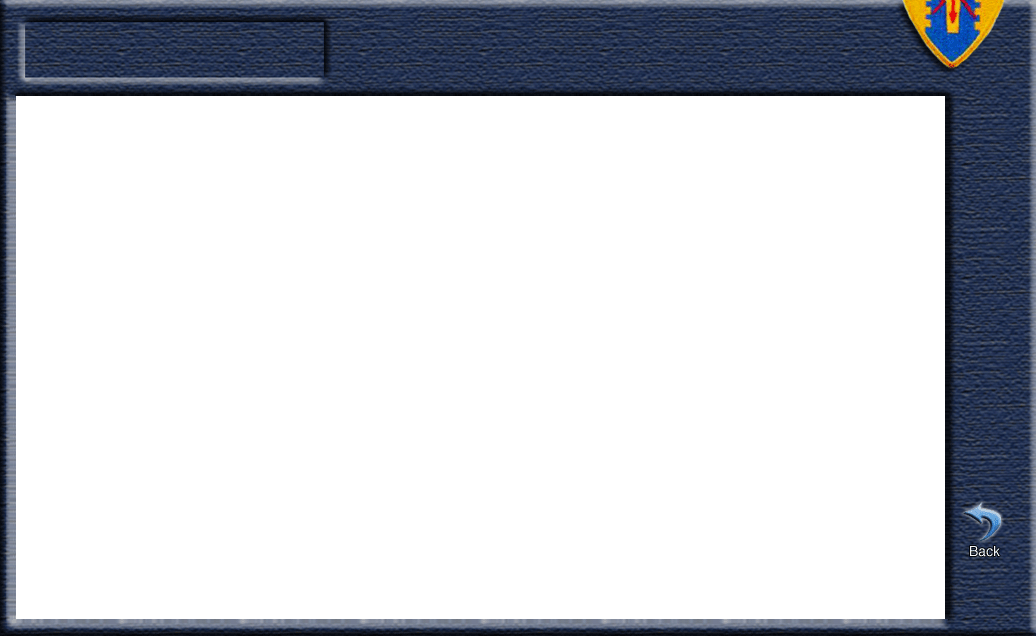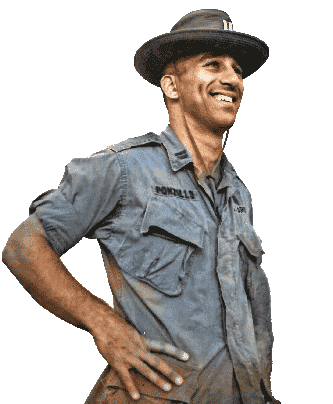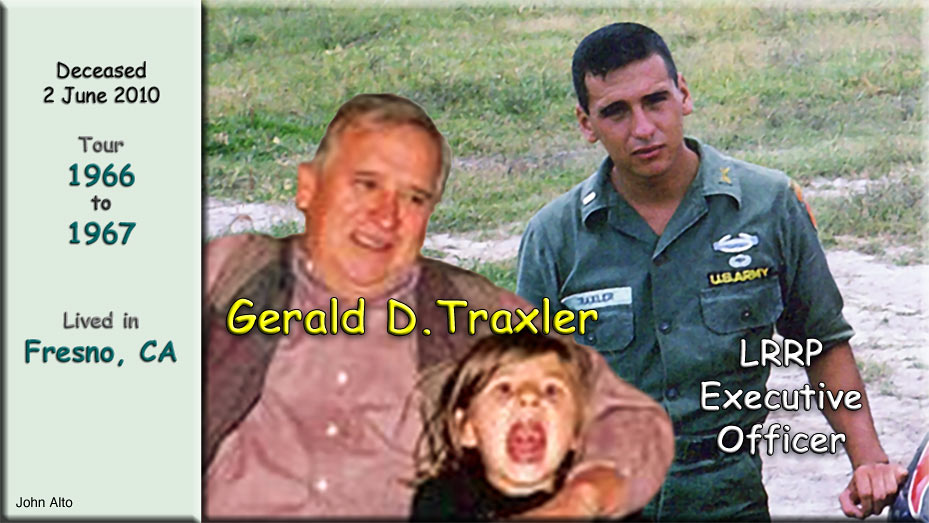

Creating the Centaur LRRPs - 1966
.....................................................................................................................................................................................
 Just after the 25th Infantry Division arrived in Vietnam and set up operations in and around Cu Chi it was decided that the efforts do a special organization to provide tactical intelligence in and around the operational area, of the division, was necessary. In March 1966 a request for an officer, schooled and experienced in Reconnaissance operations, was placed in the personal arena.
Just after the 25th Infantry Division arrived in Vietnam and set up operations in and around Cu Chi it was decided that the efforts do a special organization to provide tactical intelligence in and around the operational area, of the division, was necessary. In March 1966 a request for an officer, schooled and experienced in Reconnaissance operations, was placed in the personal arena.
While on my way from the 10th Special Forces Group (in Europe) to the 5th Special Forces Group (in country) I was pulled from the replacement station, in Saigon, late one night and sent to the 25th Infantry Division without explanation. When I got to the division base camp, at Cu Chi, I was met on the helipad by the division commander (MG Fred Weyand SIC). He said “Welcome, I’ll talk to you tomorrow about why you’re here.” (Or words to that effect) and had me taken to a GP Medium (officers tent) somewhere near the division CP. As there were no orders assigning me to the division, no one knew who I was or why I showed up at dark plus 30 minutes. I wasn’t sure why I was there. (Note: I wasn’t too happy when I was informed that there were no airborne slots in the unit) The next morning the CG introduced me to the division staff and told them of his plans for the creation of a “Recon” unit. He further said that he personally requested a Special Forces Officer for the job.
After sitting around for a few days without orders (on paper or otherwise) I started to ask about the division’s current recon unit/organization. All I got were blank stares. I then realized that the division did not have anything organized for the division level recon operations. I was assigned to the division headquarters company and detailed to the division G2. He said “…go organize a Long Range Patrol unit and keep him informed of your progress.” As an aside I was directed to be up and running by the 1st week of June 1966.
I drew a weapon and a Yellow Legal Pad, from supply, and wrote up a concept based on the Long Range Reconnaissance Patrol operations that were being conducted in Europe and which I had personal knowledge of and recent experience in that program. My plan was approved and I was given carte blanche to get things moving. I met the commander of D Trp 3/4 CAV and explained what I was attempting to do. He had all of the tactical airlift I needed therefore, I needed him and his unit. After confirming that I was under division orders to create a recon unit, he (the troop commander) lamented to my presence in his area and my forthcoming requirements for his organization.
The first thing I had to do at D Troop was to meet the pilots, so I moved in with them. I observed who seemed experienced enough and willing to get involved with the unique aspect of what would be required to support inserting and extracting LRRP teams. I gave several classes/briefings and requested volunteers (pilots) who wanted to do the over and above flying requirements.
I was now ready to recruit volunteers for the operational teams that would conduct the LRRP missions in enemy controlled areas while out of fire support range during the day and night operations. Initially, I traveled to all of the combat arms units in the Cu Chi base camp and requested the services of volunteers for special duty. (Note: I got some real good people right away. I also got some people who couldn’t find their way around Cu Chi in the daylight.)
The initial group had the hardest jobs. We had to clear an area for living and training in the troop AO. We needed shelter and basic equipment. We started acquiring equipment, without paperwork, and building a unit that no one knew what we were up to.
 To this day I don’t know how I got my XO. He showed up one day, with a ranger tab and a request to join the unit. He was a God send. After he and I culled the herd of those first volunteers who just didn’t fit the mold, he went and got some people he knew. As I didn’t know anyone in the division, I got permission to hang around the division replacement detachment and look for potential candidates for the LRRP company (Provisional). (Note: This drove the G1 crazy because we were not TO&E or TDA.) Finally, I just posted a handwritten sign that said “Volunteers Wanted for Hazardous Duty.” I figured that anyone that would go for that pitch would be a good candidate for what we were about to do.
To this day I don’t know how I got my XO. He showed up one day, with a ranger tab and a request to join the unit. He was a God send. After he and I culled the herd of those first volunteers who just didn’t fit the mold, he went and got some people he knew. As I didn’t know anyone in the division, I got permission to hang around the division replacement detachment and look for potential candidates for the LRRP company (Provisional). (Note: This drove the G1 crazy because we were not TO&E or TDA.) Finally, I just posted a handwritten sign that said “Volunteers Wanted for Hazardous Duty.” I figured that anyone that would go for that pitch would be a good candidate for what we were about to do.
While all of this personnel activity was going on, we started a training program aimed at small unit (team) operations. We also started a PT program primarily consisting of running. LRRP operations require the ability to run to live if detected by the enemy. We used to run very early in the morning to stay away from the heat. We ran close to and around the division headquarters so the staff couldn’t sleep without being aware that there were real (crazy) soldiers at work.
Some of the potential team leaders, my XO and myself got to the LRRP unit in the 1st Infantry Division. They were having success and divisional support. I wanted our senior leaders to see an actual operating unit. They were very good to us and gave us our first special unit identification - “Bush Hats”. They looked good and were functional in the bush, for a lot of reasons/purposes.
We needed some complete immersion training, before actual operations, so I sent a group of approximately 20 NCO’s to the 5th Special Forces “Delta” project which was presenting/conducting the forerunner to the Recondo School program. 5th Group gave us 100 sets of “Tiger Suits”. Great for morale and unit identification. Our division commander liked what we were about. The division staff was getting a bit wary about our special status, needs and requirements.
It was towards the end of May (no later than the 1st of June) and we put out our first patrol and confirmed some information the G2 had suspicions about. The division seemed pleased with what we could provide in support of their operational plans.
Bottom line. Between June 1st and the end of November 1966 the 25th Infantry Division LRRP Company (Provisional) acquired a lot of special communications equipment, uniforms, weapons, food and survival gear. It also conducted numerous successful operations and gained the confidence of the division commander and his staff. A lot was accomplished that others only dreamed of and brought the enemy’s denied areas and movements to the table for exploitation by the division’s combat units. Perfected operational procedures became a part of the D Troop family.
In November 1966 the LRRP’s started the biggest battle the division was involved in up to and including that time. A five man LRRP team while l laying next to a trail counted 181 NVA soldiers who passes within 10 feet of their position after midnight and were engaged mid-morning the next day. This would have never happened if it had not Ben for the LRRP team.
Stories will be written, tales will be told and repeated, memories will dim. But the impact of the men and operations of the original 25th Inf Div LRRP’s will never be totally appreciated; except by those special individuals who created, from nothing, a unit with a lineage that lives on in their recorded successes, work ethic, courage and combat initiatives which are modeled in current Army reconnaissance doctrine.
Epilogue: The 25th Inf Div LRRP Company (Provisional) was created from nothing to an operational unit in less than 2 months. Until the Army provided authorization for a TO&E Long Range Recon Company per division only the most very special of men were involved in all of the unique ramifications of the genesis of Army Long Range Reconnaissance and all that it entails.